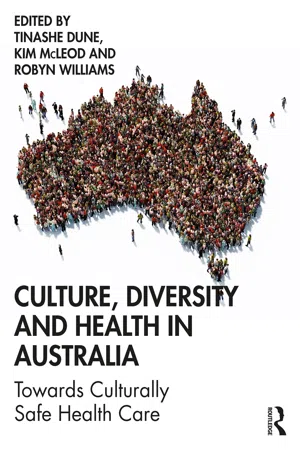
Culture, Diversity and Health in Australia
Towards Culturally Safe Health Care
- 336 pages
- English
- ePUB (mobile friendly)
- Available on iOS & Android
Culture, Diversity and Health in Australia
Towards Culturally Safe Health Care
About This Book
Australia is increasingly recognised as a multicultural and diverse society. Nationally, all accrediting bodies for allied health, nursing, midwifery and medical professions require tertiary educated students to be culturally safe with regards to cultural and social diversity. This text, drawing on experts from a range of disciplines, including public health, nursing and sociology, shows how the theory and practice of cultural safety can inform effective health care practices with all kinds of diverse populations.
Part 1 explores key themes and concepts, including social determinants of health and cultural models of health and health care. There is a particular focus on how different models of health, including the biomedical and Indigenous perspectives, intersect in Australia today. Part 2 looks at culturally safe health care practice focusing on principles and practice as well as policy and advocacy. The authors consider the practices that can be most effective, including meaningful communication skills and cultural responsiveness. Part 3 examines the practice issues in working with diverse populations, including Indigenous Australians, Culturally and Linguistically Diverse Australians, Australians with disabilities, Australians of diverse sexual orientation and gender identity, and ageing Australians. Part 4 combines all learnings from Parts 1–3 into practical learning activities, assessments and feedback for learners engaging with this textbook.
Culture, Diversity and Health in Australia is a sensitive, richly nuanced and comprehensive guide to effective health practice in Australia today and is a key reference text for either undergraduate or postgraduate students studying health care. It will also be of interest to professional health care practitioners and policy administrators.
Frequently asked questions
Part I
Understanding culture, diversity and health
1An introduction to culture, diversity and health in Australia
Learning outcomes
- Explore statistics related to Australia’s ethnic, cultural, racial and religious diversity.
- Reflect on the role of social determinants of health in a diverse Australian context.
- Understand what social constructs are, and consider their role in determining experiences of health and wellbeing.
- Consider what health and wellbeing means to people from diverse Australian perspectives.
- Understand what is meant by cultural safety and its significance in Australia.
Key terms
Chapter summary
Diversity in Australia
Country of birth, ethnicity and ancestry
Table of contents
- Cover
- Half Title
- Title Page
- Copyright Page
- Dedication
- Table of Contents
- List of figures
- List of tables
- List of boxes
- List of contributors
- Acknowledgements
- List of abbreviations
- Part I: Understanding culture, diversity and health
- Part II: Culturally safe health care practice
- Part III: Working with diverse populations
- Part IV: Culturally safe teaching and learning
- Glossary
- Index